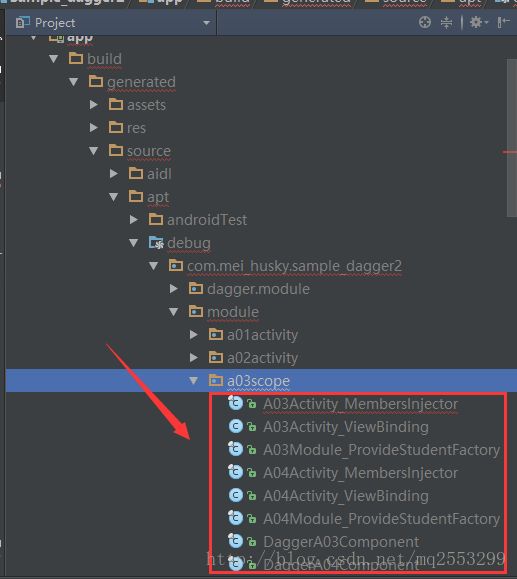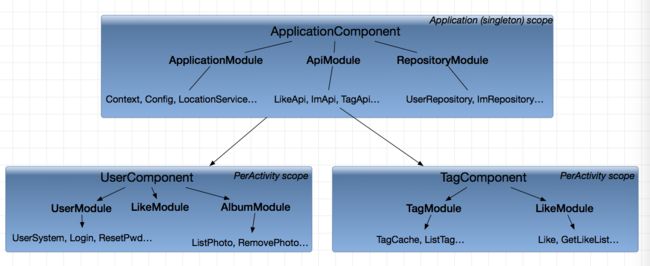Android 神兵利器Dagger2使用详解(四)Scope注解的使用及源码分析
前言
在我的上一篇文章Android 神兵利器Dagger2使用详解(三)MVP架构下的使用 中,我们以简单的案例对Dagger2依赖注入库在实际开发中的使用方法进行了学习。
本文内容:
1.@Singleton 全局单例 注解的使用
2.自定义@Scope 局部单例 注解的使用
3.通过 源码分析 @Singleton和@Scope注解是 如何实现单例 的。
一.@Singleton:全局单例注解
承接上文,我们在AppModule中提供了以下对象的初始化:
@Module
public class AppModule {
private MyApplication application;
public AppModule(MyApplication application) {
this.application = application;
}
//提供sp对象
@Provides
SharedPreferences provideSharedPreferences(){
return application.getSharedPreferences("spfile", Context.MODE_PRIVATE);
}
//提供Application对象
@Provides
MyApplication provideApplication(){
return application;
}
}我们肯定会有这样一种需求,类似于SharedPreferences对象,我们可能在整个App的生命周期中只需要一个单例,而不需要每次都通过application.getSharedPreferences(“spfile”, Context.MODE_PRIVATE)获得新的对象,那么怎么办呢,我们只需要在你需要单例的对象提供方法上加一个注解@Singleton ,类似这样:
@Module
public class AppModule {
private MyApplication application;
public AppModule(MyApplication application) {
this.application = application;
}
//全局单例SharedPreferences
@Provides
@Singleton
SharedPreferences provideSharedPreferences() {
return application.getSharedPreferences("spfile", Context.MODE_PRIVATE);
}
@Provides
MyApplication provideApplication() {
return application;
}
}只需要一个@Singleton,无论我们在多少个Activity容器中通过@Inject获取这个SharedPreferences对象的实例,该对象都是同一个对象,从而实现了全局单例的效果。
非常简单的使用方式,你需要什么对象全局单例,就在提供该对象方法的@Provides注解旁加上一个@Singleton,并且在该module关联的Component中加上同样的注解:
@Singleton //不要忘了还要在关联的Component接口中声明,否则会编译报错
@Component(modules = AppModule.class)
public interface AppComponent {
SharedPreferences sharedPreferences();
MyApplication myApplication();
}ok,使用方式很简单。
二.自定义@Scope 局部单例注解
事实上,除了全局单例,我们可能在开发中更多的是需要局部单例,比如,我在ActivityA中需要实例化两个Student对象,在ActivityB中也需要一个Student对象,但我希望ActivityA中的两个Student都叫小明,但ActivityB中的Student对象叫小刚。
这样的需求,全局单例注解@Singleton是不行的,因为如果在AppModule中通过@Singleton注解提供Student,两个Activity中的Student都是小明(全局单例)了,而如果不用@Singleton注解,那么两个Activity中的Student是三个不同的对象,这样又不满足“ActivityA中的两个Student都叫小明”的需求。
这时我们就需要自定义@Scope注解实现局部单例了。
1.自定义@Scope注解
实现方式很简单,首先这样自定义一个接口ActivityScope,声明这个注解可以使对象在同一个Activity中实现单例:
@Scope //声明这是一个自定义@Scope注解
@Retention(RUNTIME)
public @interface ActivityScope {
}
2.未使用@Scope注解效果展示:
我们先声明2个Activity及相关代码:
两个小明的Activity:
public class A03Activity extends AppCompatActivity {
@BindView(R.id.btn_login)
Button btnLogin;
@BindView(R.id.tv_student1)
TextView tvStudent1;
@BindView(R.id.tv_student2)
TextView tvStudent2;
@Inject
Student student1;
@Inject
Student student2;
@Override
protected void onCreate(Bundle savedInstanceState) {
super.onCreate(savedInstanceState);
setContentView(R.layout.activity_a03);
ButterKnife.bind(this);
DaggerA03Component.builder()
.a03Module(new A03Module(this))
.build()
.inject(this);
//打印两个Student类
tvStudent1.setText(student1.toString());
tvStudent2.setText(student2.toString());
}
@OnClick(R.id.btn_login)
public void onViewClicked() {
startActivity(new Intent(this, A04Activity.class));
}
}小刚的Activity:
public class A04Activity extends AppCompatActivity {
@BindView(R.id.tv_student)
TextView tvStudent;
@Inject
Student student;
@Override
protected void onCreate(Bundle savedInstanceState) {
super.onCreate(savedInstanceState);
setContentView(R.layout.activity_a04);
ButterKnife.bind(this);
DaggerA04Component.builder()
.a04Module(new A04Module(this))
.build()
.inject(this);
//打印Student
tvStudent.setText(student.toString());
}
}相关的两个Module:
@Module
public class A03Module {
private A03Activity activity;
public A03Module(A03Activity activity) {
this.activity = activity;
}
@Provides
Student provideStudent() {
return new Student();
}
}
@Module
public class A04Module {
private A04Activity activity;
public A04Module(A04Activity activity) {
this.activity = activity;
}
@Provides
Student provideStudent() {
return new Student();
}
}相关的Component:
@Component(modules = A03Module.class)
public interface A03Component {
void inject(A03Activity activity);
}@Component(modules = A04Module.class)
public interface A04Component {
void inject(A04Activity activity);
}可以看到,未使用自定义@Scope注解,每次@Inject注解获取的Student对象都是一个新的对象。
这样展示在界面的效果是3个不同的Student:
ActivityA中的两个Student是小明和小红(并未实现Activity局部单例)
ActivityB中的Student是小刚
3.使用自定义@Scope注解:
下面我们稍作几行代码的改变,实现Activity局部单例:
(1).在Module中添加@ActivityScope注解:
@Module
public class A03Module {
private A03Activity activity;
public A03Module(A03Activity activity) {
this.activity = activity;
}
@Provides
@ActivityScope//添加注解实现局部单例
Student provideStudent() {
return new Student();
}
}(2).在Component中同样添加@ActivityScope注解,否则会编译报错:
@ActivityScope//添加注解实现局部单例
@Component(modules = A03Module.class, dependencies = AppComponent.class)
public interface A03Component {
void inject(A03Activity activity);
}好的,仅仅添加两行注解代码,我们接下来运行看结果:
成功!我们可以看到我们成功实现了这样的效果:
ActivityA中的两个Student都是小明(Activity局部单例)
ActivityB中的Student是小刚(换了Activity,生成另外一个对象)
也就是说,在添加@ActivityScope后,该Activity中通过@Inject依赖注入生成的Student对象全部唯一,但单例范围仅仅是该Activity中,出了该Activity,生成的Student仍然是非单例的。
三.@Singleton@Scope注解原理分析
这样实在太神奇了,我们不禁想到,仅仅通过这样一个声明,就能实现对象的生成和Activity的生命周期绑定吗?只要该Activity存在,里面的Student对象就是单例?
仅仅通过这样的声明,就能实现”同生共死“吗:
@Scope
@Retention(RUNTIME) //Activity局部单例
public @interface ActivityScope {
}
@Scope
@Retention(RUNTIME) //Fragment局部单例
public @interface FragmentScope {
}
分析源码前先公布答案:
自定义的@Singleton、@ActivityScope注解根本就没有这些功能,它的作用仅仅是”标记“。
是不是难以置信,事实上的确如此,以小明的Activity为例,我们查看编译器为我们生成的源码目录:

我们发现,无论是否添加@ActivityScope注解,自动生成的文件目录中文件的数量都没有改变,如上图,也就是说:
自定义@Scope注解并没有生成任何文件。
那么自定义@Scope注解是如何实现单例的呢
(1)A03Activity_MembersInjector.java
我们轻车熟路(如果您仔细阅读了前几篇文章的话)打开这个文件,发现无论是否添加了@Scope注解,代码皆如下:
public final class A03Activity_MembersInjector implements MembersInjector {
private final Provider student1AndStudent2Provider;
public A03Activity_MembersInjector(Provider student1AndStudent2Provider) {
assert student1AndStudent2Provider != null;
this.student1AndStudent2Provider = student1AndStudent2Provider;
}
public static MembersInjector create(Provider student1AndStudent2Provider) {
return new A03Activity_MembersInjector(student1AndStudent2Provider);
}
@Override
public void injectMembers(A03Activity instance) {
if (instance == null) {
throw new NullPointerException("Cannot inject members into a null reference");
}
//请注意该行
instance.student1 = student1AndStudent2Provider.get();
instance.student2 = student1AndStudent2Provider.get();
}
public static void injectStudent1(A03Activity instance, Provider student1Provider) {
instance.student1 = student1Provider.get();
}
public static void injectStudent2(A03Activity instance, Provider student2Provider) {
instance.student2 = student2Provider.get();
}
} 需要注意的是,当我们依赖注入Activity时,最重要的其实是这两行代码:
//请注意该行
instance.student1 = student1AndStudent2Provider.get();
instance.student2 = student1AndStudent2Provider.get();无论是否添加了@ActivityScope注解,Activity中的俩个Student对象,都是通过student1AndStudent2Provider.get()进行实例化的,也就是说,当添加了@ActivityScope之后,get()方法会生成单例,否则就没有单例,我们来看一下student1AndStudent2Provider对象是如何实例化的:
private final Provider student1AndStudent2Provider;
public A03Activity_MembersInjector(Provider student1AndStudent2Provider) {
//2.构造方法中实例化student1AndStudent2Provider
assert student1AndStudent2Provider != null;
this.student1AndStudent2Provider = student1AndStudent2Provider;
}
public static MembersInjector create(Provider student1AndStudent2Provider) {
//1.有对象执行了该方法,然后执行构造方法
return new
A03Activity_MembersInjector(student1AndStudent2Provider);
} 可以看到student1AndStudent2Provider是通过有对象执行create()方法,将student1AndStudent2Provider作为参数传进来进行的初始化,我们找到执行create()方法的地方:DaggerA03Component.java
(2)DaggerA03Component.java
通过对比DaggerA03Component.java,在Provider初始化的地方,我们发现了端倪:
a.未添加@ActivityScope:
@SuppressWarnings("unchecked")
private void initialize(final Builder builder) {
//注意这行代码
this.provideStudentProvider = A03Module_ProvideStudentFactory.create(builder.a03Module);
this.a03ActivityMembersInjector = A03Activity_MembersInjector.create(provideStudentProvider);
}
b.添加了@ActivityScope:
@SuppressWarnings("unchecked")
private void initialize(final Builder builder) {
//注意这行代码,多了一个DoubleCheck.provider()方法
this.provideStudentProvider =
DoubleCheck.provider(A03Module_ProvideStudentFactory.create(builder.a03Module));
this.a03ActivityMembersInjector = A03Activity_MembersInjector.create(provideStudentProvider);
}
我们恍然大悟: @ActivityScope注解改变的只是做一个标记,然后Component将有标记的对象工厂类(本文为Student工厂)进行了一次”DoubleCheck“单例加工!
我们有理由进行这样的猜测:
1.未添加自定义@Scope:每次Activity初始化对象,直接让工厂类初始化一个对象给Activty(activity.student = new Student());
2.添加了自定义@Scope:每次Activity初始化对象,直接让工厂类将单例对象给Activty(
activity.student1 = factory.student(单例);
activity.student2 = factory.student(单例););
是不是有一点恍然大悟的感觉?我们为了验证我们猜测的正确性,我们打开DoubleCheck类进行分析:
(3*)DoubleCheck.java
public final class DoubleCheck implements Provider, Lazy {
private static final Object UNINITIALIZED = new Object();
private volatile Provider provider;
private volatile Object instance = UNINITIALIZED;
private DoubleCheck(Provider provider) {
assert provider != null;
this.provider = provider;
}
// 单例获取对象
@Override
public T get() {
Object result = instance;
if (result == UNINITIALIZED) {
synchronized (this) {
result = instance;
if (result == UNINITIALIZED) {
result = provider.get();
Object currentInstance = instance;
if (currentInstance != UNINITIALIZED && currentInstance != result) {
throw new IllegalStateException("Scoped provider was invoked recursively returning "
+ "different results: " + currentInstance + " & " + result);
}
instance = result;
provider = null;
}
}
}
return (T) result;
}
public static Provider provider(Provider delegate) {
checkNotNull(delegate);
if (delegate instanceof DoubleCheck) {
return delegate;
}
return new DoubleCheck(delegate);
}
public static Lazy lazy(Provider provider) {
if (provider instanceof Lazy) {
@SuppressWarnings("unchecked")
final Lazy lazy = (Lazy) provider;
}
return new DoubleCheck(checkNotNull(provider));
}
} 其中:
public final class DoubleCheck<T> implements Provider<T>, Lazy<T>看到这行,我们明白了,其实和普通的Provider工厂类一样,DoubleCheck也是实现了Provider接口,这样通过调用get(),就能获得对象的实例了,只不过稍微有所区别的是:
通过DoubleCheck.get()获得的对象,是单例的。
至于DoubleCheck.get()是如何实现单例的(似乎和我们普通实现单例的方式所有不同),篇幅所限,就不过多介绍,有兴趣的同学看看这篇博客 多线程问题与double-check小结 @usher,相信会有所收获。
总结
看到最后,相信大家已经对于@Scope和@Singleton的原理了解的差不多了,其实并没有什么魔力,能够真正通过一个注解,实现对Application生命周期或者Activity/Fragment生命周期进行绑定,无非做出一个标记的作用,检查到标记后,Component将对应的工厂实现单例模式,这样我们的容器去获取对象时就能实现对应的单例效果。
而对于其他的Activity,因为ActivityA和ActivityB是同一层级互不干扰的,ActivityA的Component和ActivityB的Component互不联系,当然不可能相互共享单例:
借用@MarkZhai 大神的图和一句话:位于上层的component是看不到下层的,而下层则可以使用上层的,但不能引用同一层相邻component内的实例。
同时,当我们的容器(Application/Activity/Fragment等)销毁时,对应的Component当然也不复存在,这就是为什么我们看起来@Scope能够实现”同生共死“效果的原因。
至此,Dagger2相关的知识点我们已经了解的差不多了,我们需要的就是更多的去使用它,通过它实现快速开发和代码解耦。
代码已托管Github,源码传送门,点我查看
2017/8/24日更新
事实上,Android开发中使用Dagger,开发人员仍然需要面对一些问题。
google工程师们尝试弥补Dagger的问题,于是Dagger2-Android,基于Dagger2,应用于Android开发,由google开发的的拓展库应运而生:
- 打破Dagger2使用窘境:Dagger-Android详解


